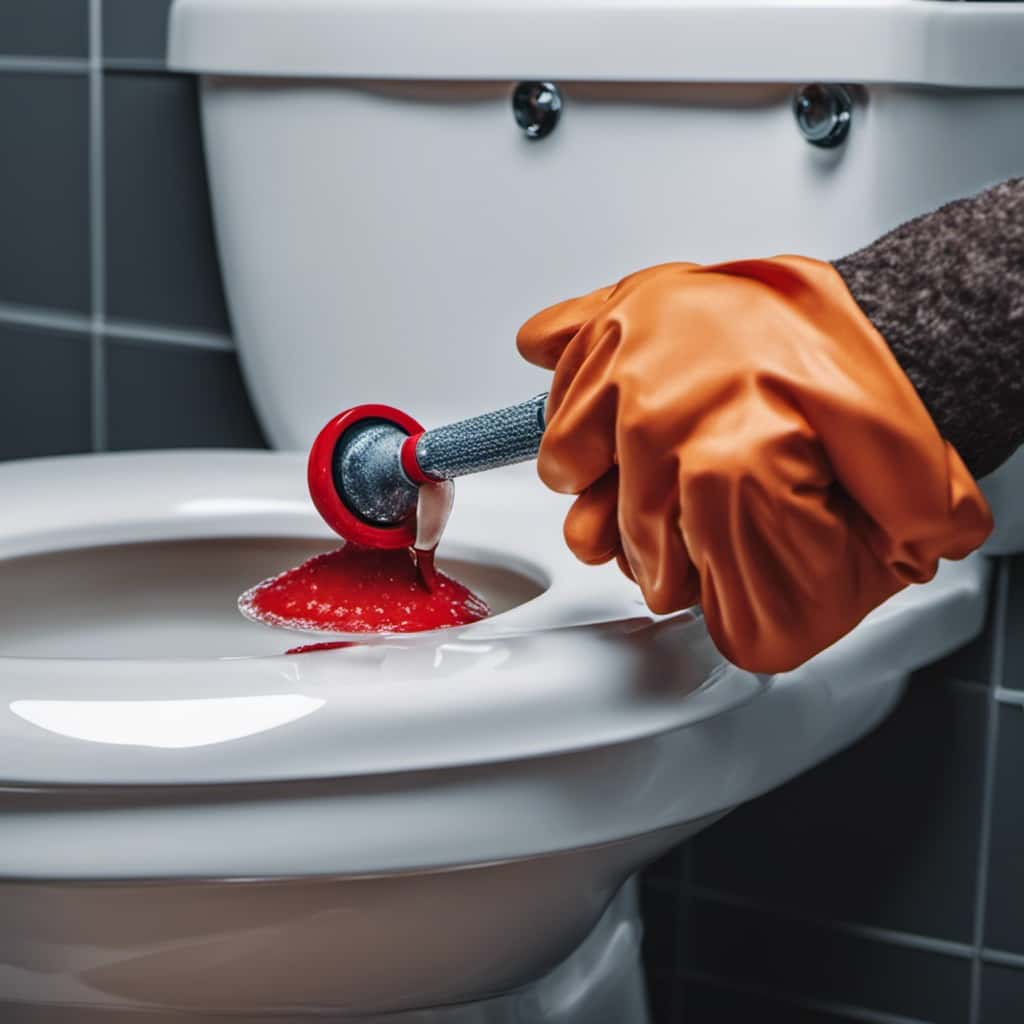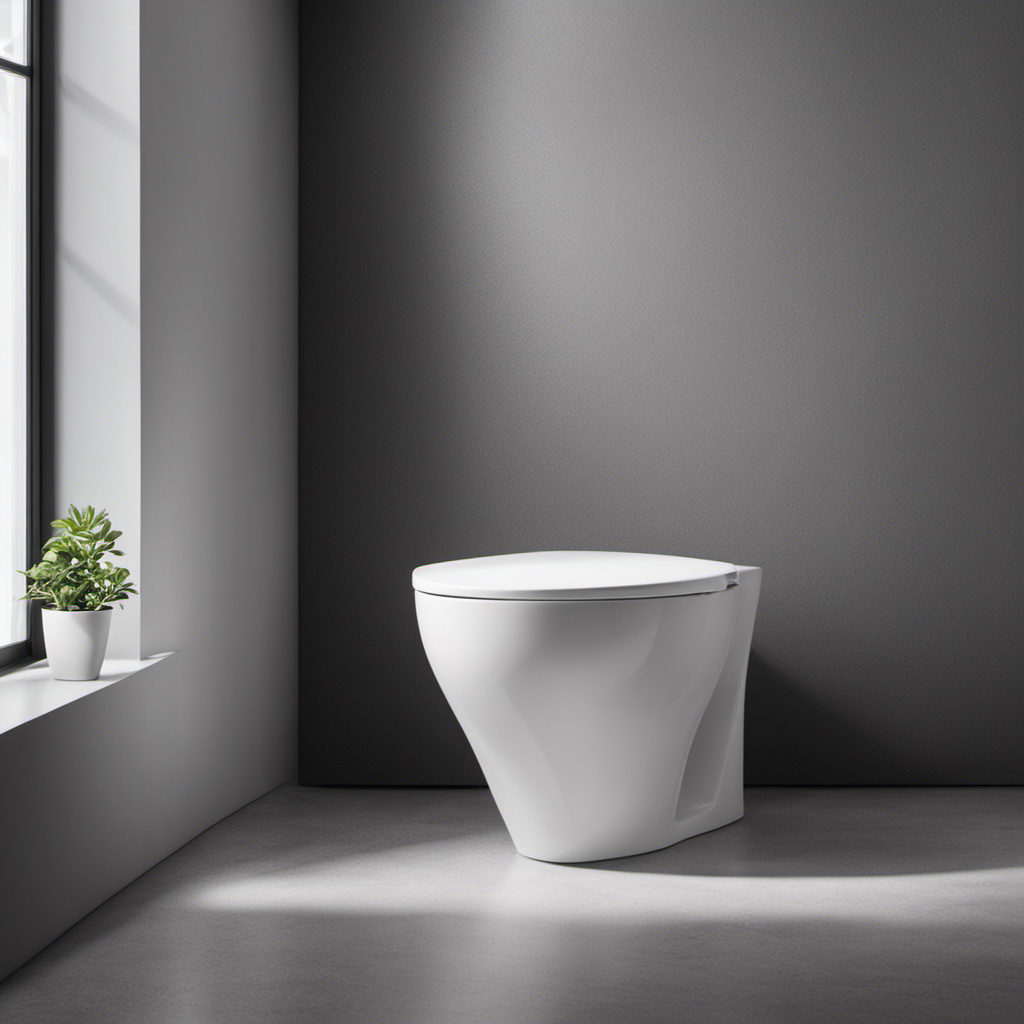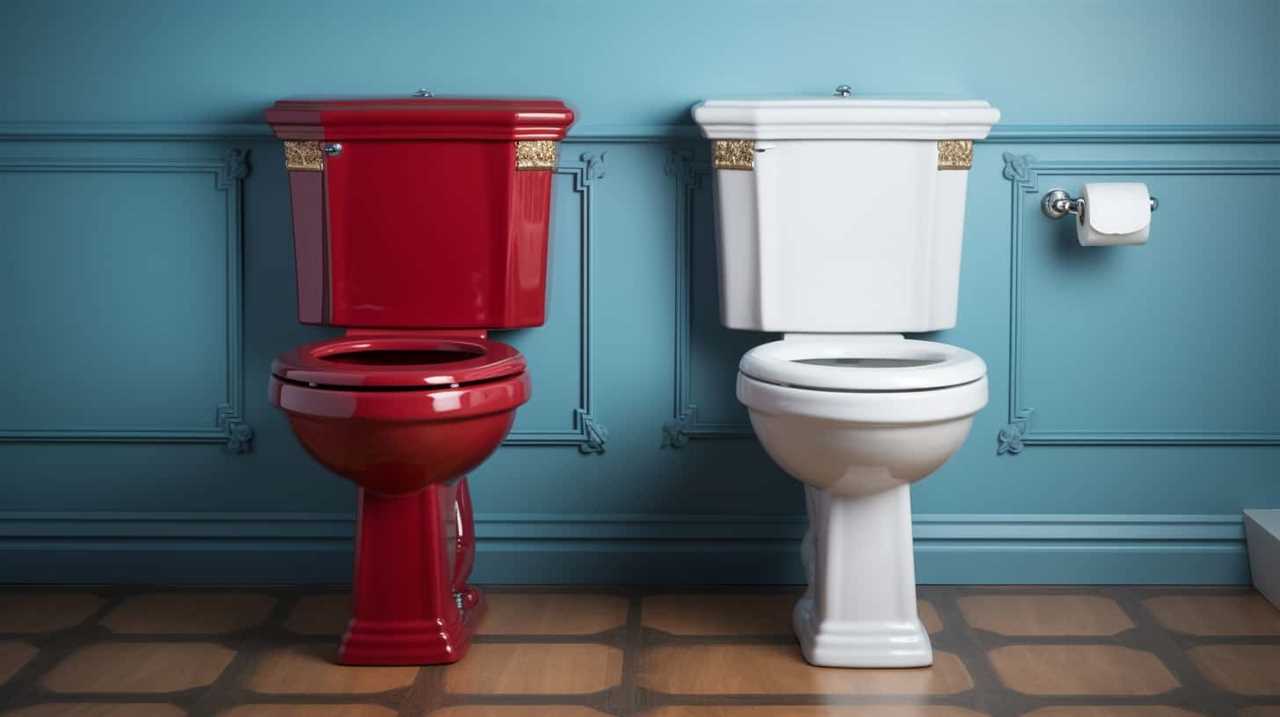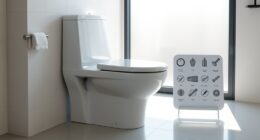We’ve all experienced it – positioned before a filthy toilet, holding a dependable cleaner for the tank, questioning whether it might actually be causing more damage than benefit. Worry not any longer!
In this article, we’ll dive into the world of in-tank cleaners and explore their potential effects on your beloved porcelain throne. From how they work to the common ingredients and risks involved, we’ll equip you with the knowledge you need to make informed decisions and keep your toilet in tip-top shape.
Key Takeaways
- In-tank cleaners can cause chemical corrosion, weakening and damage to toilet components, and long-term structural deterioration.
- Excessive use of chlorine bleach in in-tank cleaners can have harmful effects on plumbing systems and can release toxic fumes, posing health risks.
- In-tank cleaners can lead to discoloration, staining issues, residue buildup, and clogs.
- Eco-friendly alternatives to in-tank cleaners are available and can help prevent environmental impact while still providing effective cleaning.
Types of In-Tank Cleaners
There are several types of in-tank cleaners available on the market today, each designed to effectively maintain toilet cleanliness and prevent damage.
When it comes to choosing an in-tank cleaner, it’s important to consider toxicity concerns and the environmental impact. Some in-tank cleaners contain harsh chemicals that may be toxic to humans and harmful to the environment. These chemicals can cause skin irritation and respiratory problems if not handled properly. Additionally, they can contaminate water sources and harm aquatic life.

On the other hand, there are eco-friendly in-tank cleaners that use natural ingredients and biodegradable formulas. These cleaners are non-toxic, safe for humans, and have minimal impact on the environment.
It’s important to carefully read product labels and choose an in-tank cleaner that aligns with your values and concerns regarding toxicity and environmental impact.
How In-Tank Cleaners Work
To understand how in-tank cleaners work, we need to first understand the role of the toilet tank in the flushing process. The toilet tank holds water that’s released during a flush to create the necessary force to remove waste from the bowl.
In-tank cleaners are designed to enhance this process and provide several benefits:

- Continuous cleaning: In-tank cleaners are effective in keeping the toilet bowl clean by releasing cleaning agents with each flush.
- Prevention of stains and buildup: These cleaners help prevent mineral and bacteria buildup, reducing the chances of stains and odors.
- Easy maintenance: In-tank cleaners require little effort and time to maintain, as they automatically dispense cleaning agents.
- Cost-effective: Using in-tank cleaners can save money on cleaning products and reduce the need for manual scrubbing.
Common Ingredients in In-Tank Cleaners
Now that we understand how in-tank cleaners work, let’s explore the common ingredients used in these cleaners.
In order to effectively remove common toilet stains, in-tank cleaners typically contain a combination of cleaning agents and chemicals. One common ingredient is chlorine bleach, a powerful disinfectant that helps eliminate bacteria and odors. Another common ingredient is citric acid, which helps break down mineral deposits and tough stains. Additionally, surfactants are often included to help remove dirt and grime.
It’s important to note that while these ingredients are effective in cleaning toilets, they can also have harmful effects if not used properly. Excessive use of chlorine bleach, for example, can damage toilet components and cause corrosion.
Transitioning to the next section, we’ll now discuss the potential risks of using in-tank cleaners.

Potential Risks of Using In-Tank Cleaners
As we continue our exploration of in-tank cleaners, it’s important to address the potential risks associated with their use. While these cleaners are designed to keep toilets clean and fresh, they can have unintended consequences that may impact both plumbing systems and human health. Here are some key risks to consider:
- Impact on plumbing: In-tank cleaners often contain harsh chemicals that can corrode or damage the internal components of toilets. Over time, this can lead to leaks, clogs, and costly repairs.
- Health risks: Certain ingredients in in-tank cleaners, such as chlorine bleach or ammonia, can release toxic fumes when mixed with other substances commonly found in toilets, like urine. Prolonged exposure to these fumes can cause respiratory issues, skin irritation, and other health problems.
- Chemical interactions: Mixing different types of in-tank cleaners or using them in conjunction with other cleaning products can result in chemical reactions that produce harmful gases or substances. It’s crucial to read and follow the instructions provided by the manufacturers to avoid such interactions.
- Environmental impact: In-tank cleaners that contain harmful chemicals can also have a negative impact on the environment when they’re flushed down the toilet. These chemicals can enter water bodies and harm aquatic life, disrupting ecosystems.
Understanding the potential risks associated with using in-tank cleaners is essential for maintaining both the longevity of plumbing systems and the well-being of individuals. It’s important to carefully read product labels, follow instructions, and consider alternative cleaning methods to minimize these risks.
Effects of Chemicals on Toilet Components
When it comes to the effects of chemicals on toilet components, there are several important points to consider.
Firstly, there’s the risk of chemical corrosion, which can weaken and damage various parts of the toilet.

Secondly, the chemicals in in-tank cleaners can have an impact on the flushing mechanisms, potentially leading to reduced efficiency or even malfunction.
Lastly, long-term use of these cleaners can contribute to structural deterioration, causing cracks and leaks in the toilet.
Understanding these effects is crucial in making informed decisions about the use of in-tank cleaners and maintaining the longevity of toilet components.
Chemical Corrosion Risks
We have observed that certain in tank cleaners can cause significant chemical corrosion to toilet components. This chemical corrosion can lead to costly repairs and even the need for complete replacement of the toilet.

To ensure chemical safety and prevent corrosion, consider the following maintenance tips:
- Choose the right cleaner: Select a cleaner specifically formulated for toilets to minimize the risk of chemical corrosion.
- Read the label: Always read and follow the instructions provided by the manufacturer to ensure proper usage and avoid any potential damage.
- Avoid harsh chemicals: Harsh chemicals, such as bleach or ammonia-based cleaners, can accelerate corrosion. Opt for milder, non-acidic cleaners.
- Regular cleaning and inspection: Regularly clean the toilet and inspect its components for any signs of corrosion or damage. Address any issues promptly to prevent further damage.
Impact on Flushing Mechanisms
To properly assess the impact of chemicals on toilet components, it’s essential to understand how they affect the flushing mechanisms. Chemicals found in in-tank cleaners can potentially cause damage to the flushing mechanisms of toilets, leading to toilet flushing problems.
These flushing mechanisms include components such as the flapper, flush valve, and fill valve. The chemicals in these cleaners can corrode and deteriorate these components over time, resulting in leaks, poor flushing performance, and even complete failure of the toilet mechanism.
The corrosive nature of the chemicals can weaken the rubber seals and gaskets, causing them to deteriorate and ultimately leading to damage to the toilet mechanisms.

It’s crucial to be aware of the potential risks of using in-tank cleaners and to consider alternative cleaning methods that are less likely to cause damage to toilet mechanisms.
Long-Term Structural Deterioration
Over time, the chemicals in in-tank cleaners can contribute to the long-term structural deterioration of toilet components. It’s important to understand the potential effects of these chemicals on the toilet and take necessary preventive measures for proper toilet maintenance.
Here are some key points to consider:

- Continuous exposure to chemicals can weaken the structural integrity of toilet components.
- Chemicals can cause corrosion and deterioration of metal parts such as flush handles and bolts.
- Plastic components, like flapper valves and gaskets, may become brittle and prone to cracking or breaking.
- The porcelain surface of the toilet bowl can also be affected, leading to discoloration or even etching.
To prevent long-term structural deterioration, it’s recommended to:

- Use in-tank cleaners sparingly and follow the manufacturer’s instructions.
- Regularly inspect toilet components for signs of damage or wear.
- Replace worn-out parts promptly to prevent further deterioration.
- Consider using alternative cleaning methods that are less harsh on toilet components.
Understanding the potential risks and implementing preventive measures can help maintain the structural integrity of your toilet and prevent costly repairs.
Transitioning into the next section, let’s now explore the specific effects of corrosion and deterioration on toilet parts.
Corrosion and Deterioration of Toilet Parts
When it comes to the effects of in tank cleaners on toilets, one important aspect to consider is the corrosion and deterioration of toilet parts. Rust and corrosion can occur due to the chemical composition of these cleaners, leading to damage and potential failure of toilet components.
Additionally, the continuous exposure to these chemicals can result in chemical erosion, further exacerbating the deterioration of toilet parts.

It’s crucial to understand these risks in order to properly maintain and preserve the functionality of toilets.
Rust and Corrosion
How can in tank cleaners cause rust and corrosion in our toilets?
In tank cleaners can cause rust and corrosion in toilets due to various chemical reactions that occur when these cleaners come in contact with the metal and plastic parts of the toilet. The chemicals present in the cleaners can react with the metal surfaces, leading to the formation of rust and corrosion over time. This can weaken the toilet parts and eventually cause them to deteriorate.
To prevent rust and corrosion caused by in tank cleaners, here are some prevention methods to consider:

- Regular cleaning and maintenance: Regularly cleaning and maintaining the toilet can help remove any residue left by the cleaners, reducing the chances of chemical reactions.
- Use alternative cleaning methods: Consider using alternative cleaning methods such as vinegar or baking soda, which are less likely to cause rust and corrosion.
- Avoid abrasive cleaners: Avoid using cleaners that contain abrasive substances, as these can damage the toilet parts and promote rust and corrosion.
- Consult a professional: If you’re unsure about which cleaners to use or how to clean your toilet properly, it’s best to consult a professional plumber or toilet manufacturer for guidance.
Toilet Part Damage
Now that we understand how in tank cleaners can cause rust and corrosion in toilets, what are the effects of this damage on the various parts of the toilet? Toilet maintenance and repair are crucial to prevent further deterioration. The corrosion caused by in tank cleaners can lead to significant damage to the different components of the toilet, resulting in expensive repairs or replacements. Here is a table summarizing the potential effects of rust and corrosion on toilet parts:
| Toilet Part | Effects of Corrosion and Deterioration |
|---|---|
| Flush Valve | Reduced water flow, causing weak flush |
| Fill Valve | Malfunction, leading to water wastage |
| Flapper | Leakage, resulting in constant running water |
| Tank Bolts | Loosening, causing water leakage |
Regular toilet maintenance is essential to prevent these issues. Prompt toilet repair is necessary if any of these parts show signs of corrosion or deterioration. By addressing these problems early on, you can prevent further damage and ensure the optimal functioning of your toilet.
Chemical Erosion Risks
To continue our discussion on the potential damage caused by in tank cleaners, let’s now explore the risks of chemical erosion and its impact on the corrosion and deterioration of toilet parts. Chemical erosion occurs when the harsh chemicals present in in tank cleaners react with the materials of the toilet parts, leading to their corrosion and deterioration over time. This can have significant environmental impacts, as well as negatively affecting the functionality and lifespan of the toilet.
Here are some key points to consider:

- The acidic nature of certain in tank cleaners can accelerate the corrosion process, particularly on metal parts such as screws, bolts, and hinges.
- Plastic components, such as flappers and gaskets, may degrade and become brittle when exposed to certain chemicals, leading to leaks and malfunctioning.
- Chemical erosion can also affect the toilet’s porcelain surface, causing discoloration and roughening, making it more prone to stains and difficult to clean.
- It’s important to choose in tank cleaners that are specifically formulated to be compatible with toilet materials to minimize the risk of chemical erosion and the subsequent damage.
Impact on Toilet Seals and Gaskets
We have observed that in-tank cleaners can potentially cause damage to toilet seals and gaskets due to the corrosive nature of their chemical composition.
Over time, these cleaners can weaken and deteriorate the seals and gaskets, leading to leaks and other issues.
It’s important to be aware of this potential damage and take necessary precautions to prevent it. Regular maintenance is crucial to ensure the longevity of your toilet seals and gaskets.
This includes inspecting them for any signs of wear or damage, such as cracks or leaks, and promptly replacing them if necessary.

Additionally, it’s recommended to avoid using harsh chemical cleaners and opt for gentler alternatives to minimize the risk of damage.
Following these maintenance tips can help prolong the lifespan of your toilet seals and gaskets.
Discoloration and Staining Issues
One common issue caused by in-tank cleaners is the occurrence of discoloration and staining on toilets. This can be frustrating for homeowners who want to keep their toilets looking clean and presentable. There are several factors that contribute to discoloration and staining, including the chemicals used in in-tank cleaners and the buildup of mineral deposits over time.
To prevent discoloration and staining, consider the following:

- Regular cleaning using non-abrasive cleaners: Using non-abrasive cleaners can help prevent discoloration and staining on toilets.
- Avoid using harsh chemicals: Harsh chemicals can cause damage to the toilet surface and lead to discoloration.
- Use natural cleaning products: Cleaning product alternatives, such as vinegar or baking soda, can effectively clean toilets without causing discoloration.
- Regular maintenance: Regularly inspecting and cleaning the toilet can help prevent buildup and discoloration.
By following these tips, you can prevent discoloration and staining on your toilet, keeping it looking clean and well-maintained.
Now, let’s move on to the next section, which discusses the buildup of residue and clogs.
Buildup of Residue and Clogs
As we continue our discussion on the effects of in-tank cleaners on toilets, let’s now delve into the issue of the buildup of residue and clogs.
Over time, in-tank cleaners can leave behind a sticky residue that accumulates on the toilet bowl and other surfaces. This residue can attract dirt and impurities, leading to the formation of stubborn stains that are difficult to remove. Additionally, the chemicals in these cleaners can contribute to the buildup of mineral deposits, which can cause clogs in the toilet pipes.

To prevent the buildup of residue and clogs, there are several effective techniques you can employ. Regular cleaning with a mild toilet cleaner and a soft brush can help remove any residue before it becomes a problem. It’s also important to avoid using harsh chemicals that can damage the toilet and contribute to the buildup of deposits. Instead, you can opt for DIY toilet cleaner recipes using natural ingredients like vinegar and baking soda, which are effective in removing stains and preventing buildup.
Understanding the implications for water quality and safety is crucial in evaluating the impact of in-tank cleaners on toilets.
Implications for Water Quality and Safety
The buildup of residue and clogs caused by in-tank cleaners can have significant implications for the water quality and safety of a toilet. These implications include:
- Water conservation: In-tank cleaners often release chemicals that can contaminate the water supply. This contamination can lead to increased water consumption, as people may feel the need to flush multiple times to remove the residue and ensure the toilet is clean.
- Health risks: The chemicals present in in-tank cleaners can pose health risks to humans. Inhalation or contact with these chemicals can cause respiratory problems, skin irritation, and allergic reactions. Additionally, if these chemicals seep into the water supply, they can potentially harm aquatic ecosystems and contaminate drinking water sources.
- Environmental impact: In-tank cleaners contribute to water pollution, which can harm aquatic life and disrupt ecosystems. The release of these chemicals into the environment can also have long-term effects on water quality, leading to the degradation of natural habitats and posing a threat to biodiversity.
Considering the potential negative consequences for water quality, safety, and the environment, it’s crucial to explore alternative methods that can effectively clean toilets without compromising water conservation efforts and posing health risks.

Now, let’s delve into the next section about the environmental concerns with in-tank cleaners.
Environmental Concerns With In-Tank Cleaners
When it comes to in-tank cleaners, there are a few environmental concerns that need to be addressed.
One of the main concerns is the toxic chemical ingredients found in some cleaners, which can have a negative impact on water quality. These chemicals can potentially harm aquatic life and contaminate water sources.
As eco-conscious consumers, it’s important to consider alternatives that are more environmentally friendly and pose less risk to our ecosystems.

Toxic Chemical Ingredients
We have found that in-tank cleaners can pose environmental concerns due to their toxic chemical ingredients. These ingredients can have negative effects on both human health and the environment. It’s important to be aware of the potential risks associated with using these cleaners and to explore alternative options that are safer and more environmentally friendly.
Here are some toxic chemical alternatives and eco-friendly cleaning options to consider:
- Natural cleaning products: Look for cleaning products that are made with natural and biodegradable ingredients. These products are often free of harsh chemicals and toxins.
- DIY cleaners: You can make your own cleaning solutions using simple ingredients like vinegar, baking soda, and lemon juice. These ingredients are non-toxic and can be just as effective as commercial cleaners.
- Microfiber cloths: Instead of using disposable wipes or paper towels, opt for reusable microfiber cloths. They can effectively clean surfaces without the need for chemical cleaners.
- Water-saving toilets: Consider investing in water-saving toilets that use less water per flush. This not only helps to conserve water but also reduces the need for frequent cleaning.
Effect on Water Quality
Considering the potential environmental concerns with in-tank cleaners, it is important to understand their effect on water quality. In-tank cleaners can have a significant impact on the water in your toilet bowl, leading to both physical and chemical changes. One common issue is toilet bowl discoloration, which can occur due to the presence of certain chemicals in the cleaner. These chemicals can react with the minerals in the water, resulting in stains and discoloration. Additionally, some in-tank cleaners may contain toxic ingredients that can pose health risks when they come into contact with the water. It is crucial to be aware of these potential risks and choose in-tank cleaners that are environmentally friendly and safe for water quality.
| Water Quality Effects | Potential Risks |
|---|---|
| Toilet bowl discoloration | Stains and discoloration due to chemical reactions with minerals in water |
| Health risks | Exposure to toxic ingredients in the cleaner when in contact with water |
Alternatives for Eco-Conscious Consumers?
To address the environmental concerns associated with in-tank cleaners, it’s important for eco-conscious consumers to explore alternative options. There are several eco-friendly options available that provide sustainable alternatives to traditional in-tank cleaners:

- Natural cleaners: Look for toilet cleaners that are made from natural ingredients such as vinegar, baking soda, or essential oils. These cleaners are effective in removing stains and odors without harming the environment.
- Biodegradable cleaners: Choose toilet cleaners that are biodegradable and free from harsh chemicals. These cleaners break down easily in the environment, minimizing their impact on ecosystems.
- Water-saving devices: Consider installing a dual-flush toilet or a water-saving device in your existing toilet. These devices help reduce water consumption with each flush, promoting sustainability.
- DIY cleaners: Create your own toilet cleaner using simple ingredients like lemon juice, borax, and water. DIY cleaners are cost-effective and allow you to have full control over the ingredients you use.
Alternatives to In-Tank Cleaners
Using natural cleaning solutions is a practical option for maintaining toilet hygiene without resorting to in-tank cleaners. These eco-friendly alternatives are not only better for the environment but also safer for our health. Homemade cleaners can be easily made using ingredients commonly found in our kitchens, such as vinegar, baking soda, and lemon juice. These natural ingredients have powerful cleaning properties that can effectively remove stains, eliminate odors, and disinfect our toilets. To give you an idea of the effectiveness of these homemade cleaners, here is a comparison table showcasing their benefits:
| Homemade Cleaner | Benefits |
|---|---|
| Vinegar and Water | Removes stains and kills bacteria |
| Baking Soda | Deodorizes and eliminates odors |
| Lemon Juice | Dissolves mineral deposits and leaves a fresh scent |
| Essential Oils | Adds a pleasant fragrance and provides antimicrobial effects |
Tips for Safe and Effective Toilet Cleaning
When it comes to toilet cleaning, it’s important to be aware of harmful cleaning products that can damage your toilet over time. Instead, consider using natural alternatives such as vinegar or baking soda, which are effective and safe for the environment.
In addition, it’s crucial to employ proper cleaning techniques, such as using a toilet brush and scrubbing gently to avoid scratching the porcelain surface.
Harmful Toilet Cleaning Products
We recommend avoiding harmful toilet cleaning products to ensure safe and effective toilet cleaning. Using hazardous chemicals in your toilet cleaning routine can pose serious health risks and can also cause damage to your toilet over time.

To help you make informed decisions about the products you use, here are some tips for choosing safe and effective toilet cleaning products:
- Look for eco-friendly and non-toxic options that are free from harsh chemicals like bleach and ammonia.
- Consider using natural alternatives such as vinegar or baking soda, which are effective in removing stains and odors without posing health risks.
- Read product labels carefully and avoid those that contain strong fragrances or artificial dyes.
- Consider using toilet cleaning products that are specifically formulated for septic systems to prevent damage to your plumbing.
Natural Alternatives for Cleaning
To ensure both safety and effectiveness in toilet cleaning, it’s important to consider natural alternatives that prioritize the use of eco-friendly and non-toxic products.
Natural cleaning recipes can be effective in removing stains, eliminating odors, and disinfecting toilets without the use of harsh chemicals. One such recipe is a mixture of baking soda and vinegar. Simply sprinkle baking soda around the inside of the toilet bowl, then pour vinegar over it. Allow the mixture to sit for a few minutes before scrubbing with a toilet brush and flushing.
Another eco-friendly option is to use lemon juice. The citric acid in lemon juice acts as a natural cleaner and deodorizer. Squeeze a lemon or pour lemon juice into the toilet bowl, let it sit for a while, scrub, and flush.

Additionally, there are commercially available eco-friendly cleaning products specifically formulated for toilet cleaning. These products are made from plant-based ingredients and are free from harsh chemicals, making them safe for both the environment and your health.
Proper Cleaning Techniques?
For safe and effective toilet cleaning, it’s important to follow proper cleaning techniques.
Here are some best practices to ensure that your toilet is thoroughly cleaned and maintained:
- Use a toilet brush with firm bristles to scrub the bowl. Start from under the rim and work your way down to the waterline.
- Apply a toilet cleaner or disinfectant directly to the bowl’s surface and let it sit for a few minutes to break down stains and bacteria.
- Use a non-abrasive cleaner or mild detergent to clean the external surfaces of the toilet, including the seat, lid, and tank.
- Regularly clean the toilet tank to prevent the buildup of mineral deposits and bacteria. Flush the tank and scrub away any residue using a soft brush or sponge.
Proper Maintenance for Toilet Longevity
Regular maintenance is essential for maximizing the lifespan of toilets. By following proper maintenance techniques, you can ensure that your toilet remains in good working condition for years to come. Here are some tips for maintaining your toilet:

| Maintenance Task | Frequency |
|---|---|
| Check for leaks | Monthly |
| Clean the bowl | Weekly |
| Inspect the flushing mechanism | Annually |
| Replace worn-out parts | As needed |
| Use eco-friendly alternatives | Ongoing |
Checking for leaks should be done on a monthly basis to catch any potential issues early on. Cleaning the bowl weekly not only keeps it hygienic, but also prevents stains and build-up. An annual inspection of the flushing mechanism ensures that it is working properly. If any parts are worn out, they should be replaced as needed to prevent further damage. Lastly, consider using eco-friendly alternatives for toilet cleaning to minimize the impact on the environment. Following these maintenance tips will help extend the life of your toilet and keep it operating efficiently.
Final Thoughts on In-Tank Cleaner Usage
Moving forward, it’s important to consider the potential effects of in-tank cleaner usage on the longevity and functionality of toilets. While these cleaners may offer convenience, there are alternative options that can be more eco-friendly and less damaging to your toilet.
Here are some final thoughts on in-tank cleaner usage:
- Alternatives to in-tank cleaners: Consider using natural cleaning solutions such as vinegar and baking soda, which are effective in removing stains and eliminating odors without causing harm to your toilet.
- Eco-friendly cleaning options: Look for cleaning products that are labeled as environmentally friendly or biodegradable. These options are designed to minimize negative impacts on the environment while still effectively cleaning your toilet.
- Regular maintenance: Implement a regular cleaning schedule to prevent the buildup of stains and deposits. This will help maintain your toilet’s functionality and reduce the need for harsh chemical cleaners.
- Professional assistance: If you’re unsure about the best cleaning methods or if you’re experiencing persistent issues, consult a professional plumber who can provide expert advice and assistance.
Frequently Asked Questions
Can In-Tank Cleaners Cause Damage to the Toilet Bowl or Tank?
In-tank cleaners may potentially cause damage to both the toilet bowl and tank. It is important to be cautious as certain chemicals in these cleaners can lead to cracks, discoloration, or deterioration over time.

Do In-Tank Cleaners Affect the Flushing Mechanism of the Toilet?
Yes, in-tank cleaners can significantly impact the flushing mechanism of a toilet. These products can cause a range of toilet flushing problems, leading to decreased performance and potential damage to the overall system.
Are There Any Health Risks Associated With Using In-Tank Cleaners?
Using in-tank cleaners may pose health risks and safety concerns. It is important to consider the chemicals used and their potential effects on the environment. Proper ventilation and protective gear should be used when handling these products.
Can In-Tank Cleaners Cause Discoloration or Staining on Toilet Surfaces?
In-tank cleaners can cause discoloration or staining on toilet surfaces. We recommend using alternative cleaning methods, such as toilet cleaning products specifically designed to prevent discoloration, to maintain the appearance of your toilet.
Do In-Tank Cleaners Contribute to the Buildup of Residue and Clogs in the Toilet?
In-tank cleaners can contribute to residue buildup and clogs in toilets. This compromises toilet hygiene and can lead to costly repairs. Additionally, these cleaners often contain harsh chemicals that have a negative environmental impact.

Conclusion
In conclusion, it’s important to be aware of the potential risks associated with using in-tank cleaners for your toilet. The chemicals in these cleaners can cause damage to the toilet components over time.
To ensure the longevity of your toilet, consider using alternative cleaning methods and practicing proper maintenance. By doing so, you can keep your toilet clean and functional while minimizing the risk of damage.










